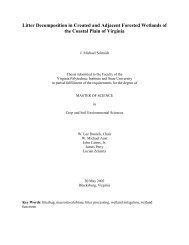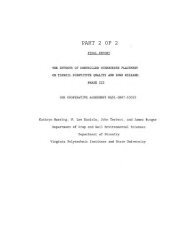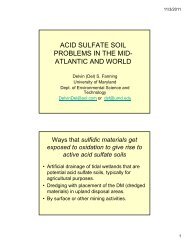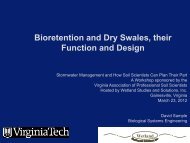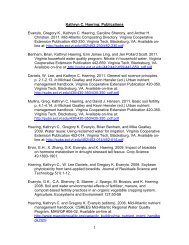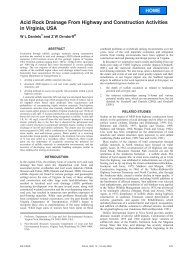Remediation of PAH-Contaminated Soils and Sediments: A ...
Remediation of PAH-Contaminated Soils and Sediments: A ...
Remediation of PAH-Contaminated Soils and Sediments: A ...
Create successful ePaper yourself
Turn your PDF publications into a flip-book with our unique Google optimized e-Paper software.
Surfactants<br />
Mass transfer <strong>of</strong> <strong>PAH</strong> compounds to the aqueous phase in the soil solution can<br />
be a major limiting factor in the bioremediation <strong>of</strong> <strong>PAH</strong>s (Volkering et al., 1992).<br />
Compounds like surfactants, cyclodextrins, <strong>and</strong> vegetable oil may be used to<br />
enhance <strong>PAH</strong> solubility.<br />
Properly applied surfactants have been shown to improve desorption, apparent<br />
aqueous mobility <strong>and</strong> bioavailability <strong>of</strong> hydrophobic organic compounds such as<br />
<strong>PAH</strong>s (Bragg et al., 1994; Mata-S<strong>and</strong>oval et al., 2002). Surfactants are<br />
amphiphilic (possess both hydrophilic <strong>and</strong> hydrophobic properties) molecules<br />
with a hydrophilic polar head (Gao et al., 2007). They can be classified by the<br />
charge on their polar head as anionic, cationic, nonionic or zwitterionic (Mulligan<br />
et al., 2001). At or above a certain concentration level called critical micelle<br />
concentration, the hydrophobic parts <strong>of</strong> the surfactants will tend to associate<br />
together to form a micelle (an aggregate <strong>of</strong> surfactant molecules dispersed in a<br />
liquid colloid) with a hydrophobic core (Santharam et al., 1997). Surfactants<br />
solubilize hydrophobic contaminants by partitioning them into the hydrophobic<br />
core <strong>of</strong> the micelle. If the concentration <strong>of</strong> surfactant exceeds the critical micelle<br />
concentration, solubility <strong>of</strong> hydrophobic compounds can increase by an order <strong>of</strong><br />
magnitude over normal aqueous solubility (Edwards et al., 1991; Mulligan et al.,<br />
2001; Gao et al., 2007). The critical micelle concentration <strong>of</strong> a specific surfactant<br />
depends on temperature, ionic strength <strong>and</strong> surfactant chemistry.<br />
� In mixed pollutant systems, the extent <strong>of</strong> solubilization will differ from<br />
those in single solutes. For example, Guha et al. (1999) found that<br />
naphthalene solubilized by surfactants increased the solubilization <strong>of</strong> other<br />
<strong>PAH</strong>s such as phenanthrene.<br />
� Surfactants are thought to be able to solubilize sorbed organic compounds<br />
in a soil-water system only after critical micelle concentration is attained<br />
(Laha <strong>and</strong> Luthy, 1991; Gao et al., 2007).<br />
� Several interactions affect the solubilization <strong>of</strong> hydrophobic compounds by<br />
surfactants. These include the micellular phase-organic interactions,<br />
surfactants monomer-organic interactions in the aqueous phase, <strong>and</strong> the<br />
interactions <strong>of</strong> surfactants <strong>and</strong> organic compounds with the solid phase<br />
(Mata-S<strong>and</strong>oval et al., 2002).<br />
� <strong>Soils</strong> with predominantly fine particles are generally found to reduce<br />
desorption efficiency <strong>of</strong> surfactants (Mulligan et al., 2001). Organic matter<br />
content <strong>and</strong> clay mineralogy also affect surfactant performance, but the<br />
effect differs depending on the type <strong>of</strong> surfactant used (Rodriquez-Cruz et<br />
al., 2005).<br />
57



